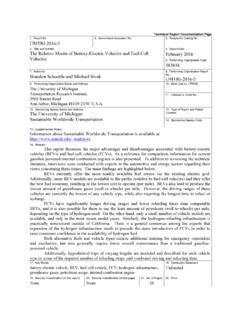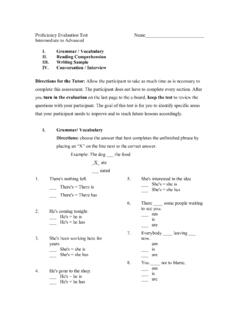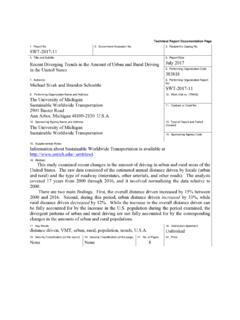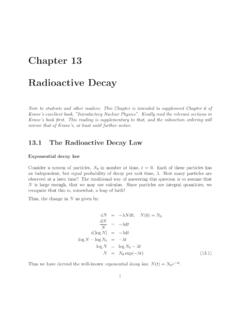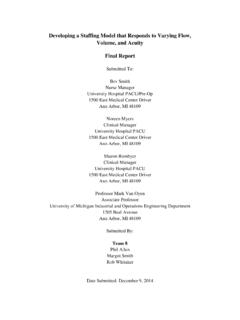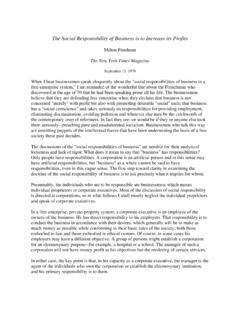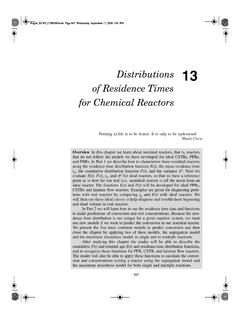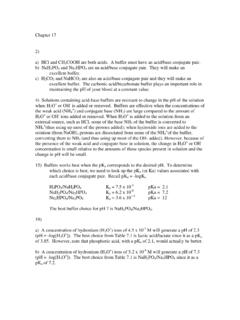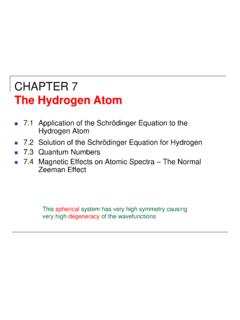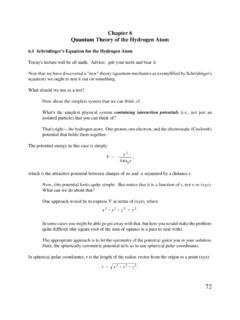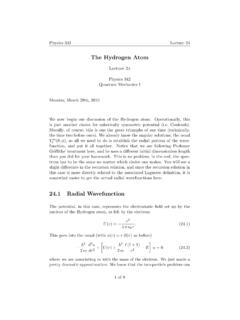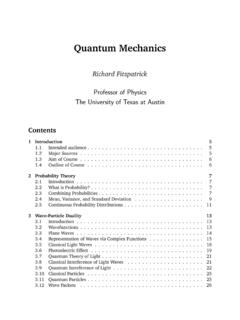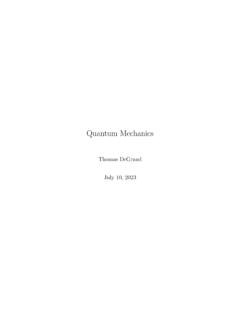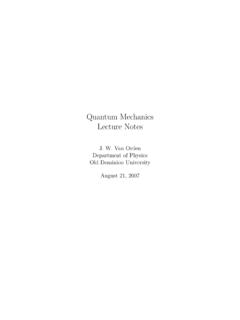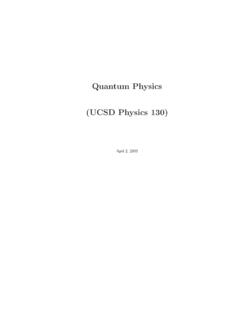Transcription of 7. The Hydrogen Atom in Wave Mechanics
1 7. The Hydrogen Atom in Wave MechanicsIn this chapter we shall discuss : The Schr odinger equation in spherical coordinates Spherical harmonics Radial probability densities The Hydrogen atom wavefunctions Angular momentum Intrinsic spin, Zeeman effect, Stern-Gerlach experiment Energy levels and spectroscopic notation, fine structureElements of Nuclear Engineering and Radiological SciencesINERS 311: Slide #1 The Schr odinger equation in spherical coordinates ..In 3D Cartesian(x, y, z)coordinates, the time-independent Schr odinger equationfor asingle particle bound by a potential,V(~x), is: ~22m 2u(~x) +V(~x)u(~x) =Eu(~x),( )where 2= 2 x2+ 2 y2+ 2 z2.
2 ( )If the potential specialized toV(~x) =V(r), whereris the distance to the origin, then,it is natural to use the spherical-polar coordinate system(r, , ).Elements of Nuclear Engineering and Radiological SciencesINERS 311: Slide # The Schr odinger equation in spherical coordinates ..where:ris the distance from origin to the particle location is the polar coordinate is the azimuthal coordinateConnection between Cartesian and spherical-polar:x rsin cos , y rsin sin , z rcos ( )WithdV= d~x= dxdydz=r2drsin d d , (volume element in both systems) dx dy dz f(x, y, z) 2 0d 0sin d 0r2dr f(r, , )( )The Laplacian operator of ( ) becomes, in spherical-polar coordinates.
3 2=R L2r2,where( )R= 2 r2+2r r,and( )L2=1sin (sin )+1sin2 2 2( )Elements of Nuclear Engineering and Radiological SciencesINERS 311: Slide # The Schr odinger equation in spherical coordinates ..SinceV(~x) =V(r), a separation of variables occurs, and the most general solution of( ) in spherical-polar coordinates is given by:unlml(r, , ) =Rnl(r)Yl,ml( , ),( )whereRRnl(r) =( 2 r2+2r r)Rnl(r) =EnlRnl(r)( )andL2Yl,ml( , ) =[1sin (sin )+1sin2 2 2]Yl,ml( , ) =l(l+ 1)Yl,ml( , )( )The radial equation, ( ) determines the energy of the system, sinceV(r)only involvesthe radial coordinate.
4 The radial wavefunctions and the quantized energies are obtainedby solving ( ). Note that the radial eigenfunctions functions and energies may dependon two quantum numbers,nandl. We shall see several examples in due angular equation, ( ), is a generic solution that applies for all the potentials of theform,V(~x) =V(r). TheYl,ml( , ) s are the eigenfunctions of the angular part of theLaplacian operator,L, withl(l+ 1)being its of Nuclear Engineering and Radiological SciencesINERS 311: Slide # The Schr odinger equation in spherical coordinatesWe have 3 quantum numbers:namerange of valuesnprincipalcan be anything, depends on the specific ofV(r)lorbital angular momentumpositive integer or 0mlorbital magnetic quantum number integer, l ml lTheir meanings are.
5 Nprimary quantum number used to quantizeElquantized orbital angular momentummay also have a role in determining the quantized Emlmeasures thez-component of the angular momentumplays no role in determining EifEdepends onnandl,D= l l1 = 2l+ 1 Elements of Nuclear Engineering and Radiological SciencesINERS 311: Slide #5 The Spherical HarmonicsYl,ml( , )..As evident in ( ), theYl,ml( , ) s are the eigenfunctions of the angular part of theLaplacian,L2Yl,ml( , ) =l(l+ 1)Yl,ml( , ),with eigenvaluel(l+ 1).Low-order explicit forms:l mlYl,ml( , )0 0(14 )1/21 0, 1(34 )1/2cos , (38 )1/2sin e i 2 0, 1, 2 (516 )1/2(3 cos2 1), (158 )1/2sin cos e i ,(1532 )1/2sin2 e i2.
6 Elements of Nuclear Engineering and Radiological SciencesINERS 311: Slide # The Spherical HarmonicsYl,ml( , )..The general form is:Yl,ml( , ) = ( 1)ml[2l+ 14 (l ml)!(l+ml)!]1/2 Pmll(cos )eiml ( )where thePmll s are the associated Legendre polynomials . (You may be familiar withthe usual Legendre polynomials, thePl s. They are a special case of thePmll s obtainedby settingml= most useful identities and recursion relationships forthe generating all of the associ-ated Legendre polynomials are:Pl+1l+1(cos ) = (2l+ 1) sin Pll(cos )( )Pll(cos ) = ( 1)l(2l 1)!)
7 !(1 cos2 )l/2( )Pll+1(cos ) = cos (2l+ 1)Pll(cos )( )(l ml+ 1)Pmll+1(cos ) = (2l+ 1) cos Pmll(cos ) (l+ml)Pmll 1(cos )( )2mlcos Pmll(cos ) = sin [Pml+1l(cos ) + (l+ml)(l ml+ 1)Pml 1l(cos )]( )Elements of Nuclear Engineering and Radiological SciencesINERS 311: Slide # The Spherical HarmonicsYl,ml( , )..The relationship between thePmll s for negativemlis:P mll(cos ) = ( 1)ml(l ml)!(l+ml)!Pmll(cos ).( )The complex conjugate ofYl,ml( , )is given by:Y l,ml( , ) =Yl, ml( , )( )The statement of orthonormality is: l,l ml,m l =hl, ml|l , m l i= 2 0d 0sin d Y l,ml( , )Yl ,m l ( , )( )Recalling that the parity operator has the effect: [( , )] = ( , + ),( )it follows that [Yl,ml( , )] = ( 1)lYl,ml( , ),( )Elements of Nuclear Engineering and Radiological SciencesINERS 311.
8 Slide # The Spherical HarmonicsYl,ml( , )Finally, theml s are the quantum number associated with the azimuthal component(equivalently, thezcomponent of the angular momentum).From the general form ( ),LzYl,ml( , ) = i( )Yl,ml( , ) =mlYl,ml( , ).( )Elements of Nuclear Engineering and Radiological SciencesINERS 311: Slide #9 Radial wave functions ..As we have seen, for potentials of the form,V(~x) =V(r), the angular part of the of theLaplacian in the Schr odinger equation, theL, given in ( ), is completely fact, it was discovered, and its solutions explored (eventually to become known as spher-ical harmonics) in a paper written by Laplace in 1783, well before Quantum Mechanics , byPierre-Simon Laplace (1749 1827).
9 It even predated Electromagnetism and Maxwell sequations. Laplace was an astronomer, as well as a Mathematician, and his applicationwas in the classical Mechanics of celestial applications are many! From Wikipedia: Spherical harmonics are important in manytheoretical and practical applications, particularly in the computation of atomic orbitalelectron configurations, representation of gravitationalfields, geoids, and the magneticfields of planetary bodies and stars, and characterization of the cosmic microwave back-ground radiation.
10 In 3D computer graphics, spherical harmonics play a special role in awide variety of topics including indirect lighting (ambient occlusion, global illumination,precomputed radiance transfer, etc.) and modeling of 3D will encounter them in many applications in your technical of Nuclear Engineering and Radiological SciencesINERS 311: Slide #10 Radial wave functionsReturning to quantum Mechanics , we substitute theYl,ml( , ) s into the Schr odingerequation ~22m[R L2r2]Rnl(r)Yl,ml( , ) +V(r)Rnl(r)Yl,ml( , ) =EnlRnl(r)Yl,ml( , )( )operate usingL2onYl,ml( , ), and divide byYl,ml( , )to obtain.
